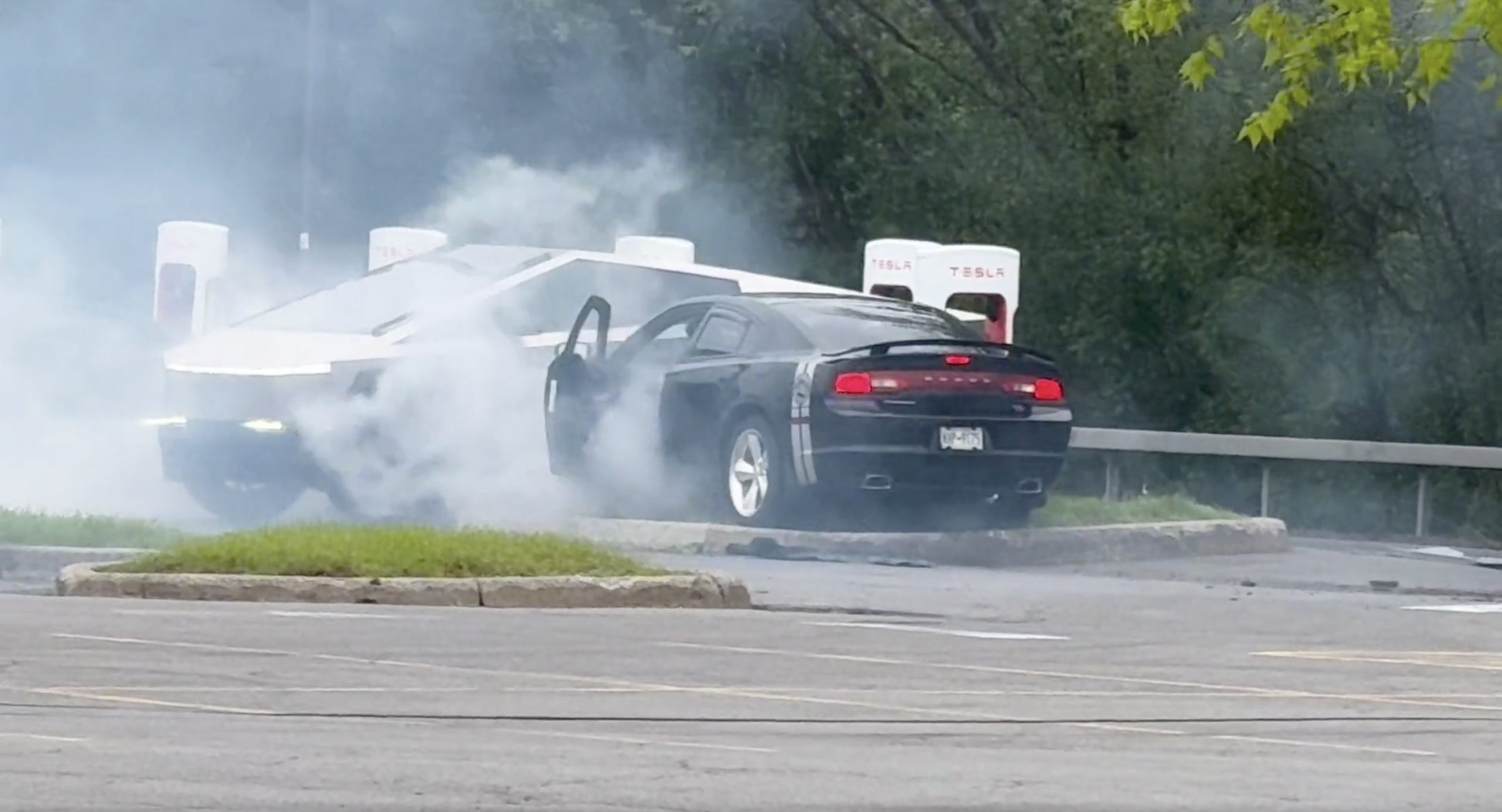

Lifestyle
How could Tesla’s Sentry Mode be taken more seriously by law enforcement?
Tesla’s Sentry Mode has been making headlines since it launched in February this year, capturing outrageous acts of vandalism, theft, and even a hit-and-run by a local politician. Despite the publicity, however, it doesn’t seem as though the unique security feature is necessarily moving things along on the legal side.
Police reports made by Tesla owners after becoming burglary victims are seeing long delays before investigations are made, if they are made to begin with. Altogether, this means that Sentry Mode isn’t necessarily giving Tesla owners any advantage over not having the feature at all. What can be done to change this?
One effective route thus far has been media attention. A burglary captured by Sentry Mode in April, for instance, was reported by a local ABC news station, and the suspect was arrested afterwards arguably in response to the public pressure surrounding the event. When the car’s owner originally turned the footage into police, he was simply informed that an officer “might” look into the incident. Of course, every incident can’t be handled this way, and it’s only the most egregious ones that capture enough interest for major media attention.
Obviously, judicial systems vary by region as do police policies and resources, all affecting the outcome of a break in report to include whether public attention is required for a quick result. A fair assessment should acknowledge these facts. But a tool like Sentry Mode should be able to deliver a more consistent legal result for Tesla owners using the feature – that is its primary purpose, is it not? Not only that, but if justice is served effectively based on Sentry Mode’s unique tools, it can finally have its desired effect of acting as a deterrent to thieves and other criminals made aware of Tesla cars’ video recording capabilities.

Here’s the scenario that’s playing out right now.
Imagine that your Tesla was broken into while you were out shopping. Your car’s app notified you of an intrusion, but you missed the thief getting away. Thank goodness you have a Tesla, you might think next. Sentry Mode recorded the entire event and the idiot who smashed your rear quarter window gave the car’s cameras a clear image of their face and the license plate of their getaway vehicle. You take the footage to the police where you expect an easy path to justice, except that’s not what happens.
“Someone will review your report in about 20-30 days,” an employee at the police station tells you when you file your theft report. If that’s not difficult enough to hear, others who’ve had similar instances with their Tesla vehicles confirm to you that they’ve had the same thing happen to them. This example isn’t fictional, either. A Tesla owner recently posted the experience on Reddit, detailing their frustration with getting a Sentry Mode video to the correct desk at their local police department.
The same Reddit user cited above proposed another solution for helping move these kinds of theft investigations along. Tesla’s app could provide a feature that automates the police report process.
In concept, following a criminal incident recorded by Sentry Mode, a programming script could run on the Tesla app to gather all pertinent information about the event. GPS data for the break in location, the owner’s name, address, and VIN number would be pulled first, then the owner could be prompted to add photos of the damage along with any witness information. A PDF or similar document would be generated, ready for printing and submission to the proper police authorities.

The Tesla owner would initiate this process with the push of a button on the car’s center touchscreen or from their phone. This solution is based on the idea that complete information in the hands of the right people might help to bring quicker legal results. Most of the tedious footwork would be done at an advantage to police.
Even better, police departments could adopt ‘dash cam friendly’ policies that made this type of reporting procedure seamless, perhaps providing a fax number, email address, or online submission form specifically for these types of events. The police department in Moorestown, New Jersey, for instance, already has an online reporting portal enabling the submission of anonymous tips, property damage, identity theft, lost property, retail crimes, and vehicle burglary reports, among others. A few experiences with the Sentry Mode reports would make it clear to authorities how much easier the cases were to investigate given the amount of information available, which could help bring better (and faster) legal results for the owners.
Expanding on that idea, perhaps a database containing reporting requirements and local police data could be maintained by Tesla owners as a community effort to make the feature more helpful and kept up-to-date. Many reporting forms are already available online, but copies of blank reports could be provided by local police departments to further streamline the data generated as suggested previously. The crafted app-made police report would be tailored for the police department local to where the break in took place.
This is something that would take time and effort, but once it became known that Tesla vehicles were being specifically targeted for theft, a major part of what drove the creation of Sentry Mode, the community came together to advise one another on preventing incidents, even compiling tip sheets on Internet forums and creating 3D-printable locking devices. It wouldn’t be a far stretch to see the community come together again to help bring justice for the break ins it previously worked together to prevent. A third-party app providing this report generation service is also a possibility.
The original rallying cry for a tool to help against break ins made its way up to Tesla CEO Elon Musk, and the response was eventually met with Bach’s Toccata and Fugue in D Minor. Perhaps a handy police report button is another possibility?
Elon Musk
X account with 184 followers inadvertently saves US space program amid Musk-Trump row
Needless to say, the X user has far more than 184 followers today after his level-headed feat.

An X user with 184 followers has become the unlikely hero of the United States’ space program by effectively de-escalating a row between SpaceX CEO Elon Musk and President Donald Trump on social media.
Needless to say, the X user has far more than 184 followers today after his level-headed feat.
A Near Fall
During Elon Musk and Donald Trump’s fallout last week, the U.S. President stated in a post on Truth Social that a good way for the United States government to save money would be to terminate subsidies and contracts from the CEO’s companies. Musk responded to Trump’s post by stating that SpaceX will start decommissioning its Dragon spacecraft immediately.
Musk’s comment was received with shock among the space community, partly because the U.S. space program is currently reliant on SpaceX to send supplies and astronauts to the International Space Station (ISS). Without Dragon, the United States will likely have to utilize Russia’s Soyuz for the same services—at a significantly higher price.
X User to the Rescue
It was evident among X users that Musk’s comments about Dragon being decommissioned were posted while emotions were high. It was then no surprise that an X account with 184 followers, @Fab25june, commented on Musk’s post, urging the CEO to rethink his decision. “This is a shame this back and forth. You are both better than this. Cool off and take a step back for a couple days,” the X user wrote in a reply.
Much to the social media platform’s surprise, Musk responded to the user. Even more surprising, the CEO stated that SpaceX would not be decommissioning Dragon after all. “Good advice. Ok, we won’t decommission Dragon,” Musk wrote in a post on X.
Not Planned, But Welcomed
The X user’s comment and Musk’s response were received extremely well by social media users, many of whom noted that @Fab25june’s X comment effectively saved the U.S. space program. In a follow-up comment, the X user, who has over 9,100 followers as of writing, stated that he did not really plan on being a mediator between Musk and Trump.
“Elon Musk replied to me. Somehow, I became the accidental peace broker between two billionaires. I didn’t plan this. I was just being me. Two great minds can do wonders. Sometimes, all it takes is a breather. Grateful for every like, DM, and new follow. Life’s weird. The internet’s weirder. Let’s ride. (Manifesting peace… and maybe a Model Y.)” the X user wrote.
Lifestyle
Tesla Cybertruck takes a bump from epic failing Dodge Charger
The Cybertruck seemed unharmed by the charging Charger.

There comes a time in a driver’s life when one is faced with one’s limitations. For the driver of a Dodge Charger, this time came when he lost control and crashed into a Tesla Cybertruck–an absolute epic fail.
A video of the rather unfortunate incident was shared on the r/TeslaLounge subreddit.
Charging Charger Fails
As could be seen in the video, which was posted on the subreddit by Model Y owner u/Hammer_of_something, a group of teens in a Dodge Charger decided to do some burnouts at a Tesla Supercharger. Unfortunately, the driver of the Charger failed in his burnout or donut attempt, resulting in the mopar sedan going over a curb and bumping a charging Cybertruck.
Ironically, the Dodge Charger seemed to have been parked at a Supercharger stall before its driver decided to perform the failed stunt. This suggests that the vehicle was likely ICE-ing a charging stall before it had its epic fail moment. Amusingly enough, the subreddit member noted that the Cybertruck did not seem like it took any damage at all despite its bump. The Charger, however, seemed like it ran into some trouble after crashing into the truck.
Alleged Aftermath
As per the the r/TeslaLounge subreddit member, the Cybertruck owner came rushing out to his vehicle after the Dodge Charger crashed into it. The Model Y owner then sent over the full video of the incident, which clearly showed the Charger attempting a burnout, failing, and bumping into the Cybertruck. The Cybertruck owner likely appreciated the video, in part because it showed the driver of the Dodge Charger absolutely freaking out after the incident.
The Cybertruck is not an impregnable vehicle, but it can take bumps pretty well thanks to its thick stainless steel body. Based on this video, it appears that the Cybertruck can even take bumps from a charging Charger, all while chilling and charging at a Supercharger. As for the teens in the Dodge, they likely had to provide a long explanation to authorities after the incident, since the cops were called to the location.
Lifestyle
Anti-Elon Musk group crushes Tesla Model 3 with Sherman tank–with unexpected results
Ironically enough, the group’s video ended up highlighting something very positive for Tesla.

Anti-Elon Musk protesters and critics tend to show their disdain for the CEO in various ways, but a recent video from political action group Led By Donkeys definitely takes the cake when it comes to creativity.
Ironially enough, the group’s video also ended up highlighting something very positive for Tesla.
Tank vs. Tesla
In its video, Led By Donkeys featured Ken Turner, a 98-year-old veteran who served in the British army during World War II. The veteran stated that Elon Musk, the richest man in the world, is “using his immense power to support the far-right in Europe, and his money comes from Tesla cars.”
He also noted that he had a message for the Tesla CEO: “We’ve crushed fascism before and we’ll crush it again.” To emphasize his point, the veteran proceeded to drive a Sherman tank over a blue Tesla Model 3 sedan, which, of course, had a plate that read “Fascism.”
The heavy tank crushed the Model 3’s glass roof and windows, much to the delight of Led By Donkeys’ commenters on its official YouTube channel. But at the end of it all, the aftermath of the anti-Elon Musk demonstration ended up showcasing something positive for the electric vehicle maker.
Tesla Model 3 Tanks the Tank?
As could be seen from the wreckage of the Tesla Model 3 after its Sherman encounter, only the glass roof and windows of the all-electric sedan were crushed. Looking at the wreckage of the Model 3, it seemed like its doors could still be opened, and everything on its lower section looked intact.
Considering that a standard M4 Sherman weighs about 66,800 to 84,000 pounds, the Model 3 actually weathered the tank’s assault really well. Granted, the vehicle’s suspension height before the political action group’s demonstration suggests that the Model 3’s high voltage battery had been removed beforehand. But even if it hadn’t been taken off, it seemed like the vehicle’s battery would have survived the heavy ordeal without much incident.
This was highlighted in comments from users on social media platform X, many of whom noted that a person in the Model 3 could very well have survived the ordeal with the Sherman. And that, ultimately, just speaks to the safety of Tesla’s vehicles. There is a reason why Teslas consistently rank among the safest cars on the road, after all.
-

 Elon Musk1 week ago
Elon Musk1 week agoTesla investors will be shocked by Jim Cramer’s latest assessment
-

 News2 weeks ago
News2 weeks agoTesla Robotaxi’s biggest challenge seems to be this one thing
-

 Elon Musk1 day ago
Elon Musk1 day agoElon Musk confirms Grok 4 launch on July 9 with livestream event
-

 News2 weeks ago
News2 weeks agoWatch the first true Tesla Robotaxi intervention by safety monitor
-

 News5 days ago
News5 days agoTesla Model 3 ranks as the safest new car in Europe for 2025, per Euro NCAP tests
-

 Elon Musk2 weeks ago
Elon Musk2 weeks agoA Tesla just delivered itself to a customer autonomously, Elon Musk confirms
-

 Elon Musk2 weeks ago
Elon Musk2 weeks agoElon Musk confirms Tesla Optimus V3 already uses Grok voice AI
-

 Elon Musk2 weeks ago
Elon Musk2 weeks agoxAI welcomes Memphis pollution results, environmental groups push back


















